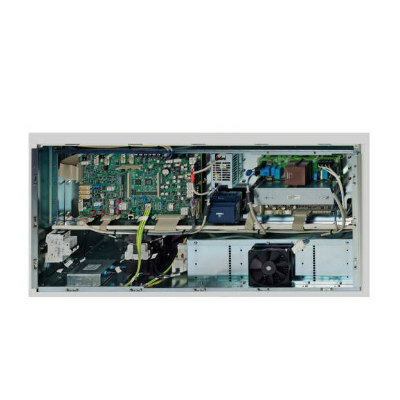Growing Inclination Towards Handheld Ultrasound Scanners for POC Diagnostics
|
By MedImaging International staff writers Posted on 10 Sep 2019 |

Image: The Lumify handheld ultrasound scanner (Photo courtesy of Philips Healthcare).
The global handheld ultrasound scanners market was valued at USD 62.2 million in 2017 and is projected to grow at a CAGR of 17% during the forecast period 2018-2026, driven primarily by their increasingly popularity among clinicians across the world for point-of-care diagnosis.
These are the latest findings of Research and Markets, (Dublin, Ireland), a global market research company.
Over the last decade, the handheld ultrasound scanners market has flourished due to several major medical devices companies coming up with portable and handheld ultrasound devices. The uptake of handheld ultrasound units is increasing rapidly due to low market entry barriers as the regulatory scenario for portable ultrasound is not defined in many regions and advances in consumer electronics have made it inexpensive to design and manufacture handheld ultrasound devices. As compared to conventional ultrasound devices, handheld ultrasound scanners offer some major advantages such as portability, ease of use and inexpensiveness. Additionally, handheld ultrasound scanners are equipped with minimum wires, cloud sharing facility, advanced imaging quality and adequate battery life, thus making ultrasound more portable and less infrastructure-dependent.
Based on technology, 2D ultrasound scanners held the largest share of the handheld scanners market in 2018 due to the growing demand for efficient and better imaging quality, rapid introduction of handheld 2D ultrasound products by the majority of manufacturers and higher demand for these devices from physicians. Handheld 3D ultrasound scanners are comparatively less inexpensive than conventional cart-based ultrasound scanners and provide similar image quality, thus driving the increased preference for handheld 3D ultrasound scanners among healthcare practitioners. Hence, 3D handheld ultrasound scanners are expected to grow at steady rate during the forecast period due to their increased application in point-of-care diagnostics.
Geographically, North America held the largest share of the global handheld ultrasound scanners market and is expected to grow at a steady rate during the forecast period, led by higher adoption of novel technology and increased approvals for a number of handheld ultrasound scanners in the region. Additionally, the increasing number ambulatory care centers in the US will generate demand for portable ultrasound devices. The European handheld ultrasound scanners market also holds high growth potential due to the growing clinical applications of high intensity focused ultrasound, commercialization of a number of portable ultrasound devices and increased minimally invasive practices in the region.
On the other hand, the handheld ultrasound scanners market in Asia Pacific is expected to grow rapidly owing to the increase in the number of standalone clinics and diagnostics centers across the region. Lower prices, easy availability and the requirement for less skilled personnel to operate these products will trigger market growth in price sensitive regions, such as Asia Pacific.
Related Links:
Research and Markets
These are the latest findings of Research and Markets, (Dublin, Ireland), a global market research company.
Over the last decade, the handheld ultrasound scanners market has flourished due to several major medical devices companies coming up with portable and handheld ultrasound devices. The uptake of handheld ultrasound units is increasing rapidly due to low market entry barriers as the regulatory scenario for portable ultrasound is not defined in many regions and advances in consumer electronics have made it inexpensive to design and manufacture handheld ultrasound devices. As compared to conventional ultrasound devices, handheld ultrasound scanners offer some major advantages such as portability, ease of use and inexpensiveness. Additionally, handheld ultrasound scanners are equipped with minimum wires, cloud sharing facility, advanced imaging quality and adequate battery life, thus making ultrasound more portable and less infrastructure-dependent.
Based on technology, 2D ultrasound scanners held the largest share of the handheld scanners market in 2018 due to the growing demand for efficient and better imaging quality, rapid introduction of handheld 2D ultrasound products by the majority of manufacturers and higher demand for these devices from physicians. Handheld 3D ultrasound scanners are comparatively less inexpensive than conventional cart-based ultrasound scanners and provide similar image quality, thus driving the increased preference for handheld 3D ultrasound scanners among healthcare practitioners. Hence, 3D handheld ultrasound scanners are expected to grow at steady rate during the forecast period due to their increased application in point-of-care diagnostics.
Geographically, North America held the largest share of the global handheld ultrasound scanners market and is expected to grow at a steady rate during the forecast period, led by higher adoption of novel technology and increased approvals for a number of handheld ultrasound scanners in the region. Additionally, the increasing number ambulatory care centers in the US will generate demand for portable ultrasound devices. The European handheld ultrasound scanners market also holds high growth potential due to the growing clinical applications of high intensity focused ultrasound, commercialization of a number of portable ultrasound devices and increased minimally invasive practices in the region.
On the other hand, the handheld ultrasound scanners market in Asia Pacific is expected to grow rapidly owing to the increase in the number of standalone clinics and diagnostics centers across the region. Lower prices, easy availability and the requirement for less skilled personnel to operate these products will trigger market growth in price sensitive regions, such as Asia Pacific.
Related Links:
Research and Markets
Latest Industry News News
- Bayer and Google Partner on New AI Product for Radiologists
- Samsung and Bracco Enter Into New Diagnostic Ultrasound Technology Agreement
- IBA Acquires Radcal to Expand Medical Imaging Quality Assurance Offering
- International Societies Suggest Key Considerations for AI Radiology Tools
- Samsung's X-Ray Devices to Be Powered by Lunit AI Solutions for Advanced Chest Screening
- Canon Medical and Olympus Collaborate on Endoscopic Ultrasound Systems
- GE HealthCare Acquires AI Imaging Analysis Company MIM Software
- First Ever International Criteria Lays Foundation for Improved Diagnostic Imaging of Brain Tumors
- RSNA Unveils 10 Most Cited Radiology Studies of 2023
- RSNA 2023 Technical Exhibits to Offer Innovations in AI, 3D Printing and More
- AI Medical Imaging Products to Increase Five-Fold by 2035, Finds Study
- RSNA 2023 Technical Exhibits to Highlight Latest Medical Imaging Innovations
- AI-Powered Technologies to Aid Interpretation of X-Ray and MRI Images for Improved Disease Diagnosis
- Hologic and Bayer Partner to Improve Mammography Imaging
- Global Fixed and Mobile C-Arms Market Driven by Increasing Surgical Procedures
- Global Contrast Enhanced Ultrasound Market Driven by Demand for Early Detection of Chronic Diseases
Channels
Radiography
view channel
Novel Breast Imaging System Proves As Effective As Mammography
Breast cancer remains the most frequently diagnosed cancer among women. It is projected that one in eight women will be diagnosed with breast cancer during her lifetime, and one in 42 women who turn 50... Read more
AI Assistance Improves Breast-Cancer Screening by Reducing False Positives
Radiologists typically detect one case of cancer for every 200 mammograms reviewed. However, these evaluations often result in false positives, leading to unnecessary patient recalls for additional testing,... Read moreMRI
view channel
PET/MRI Improves Diagnostic Accuracy for Prostate Cancer Patients
The Prostate Imaging Reporting and Data System (PI-RADS) is a five-point scale to assess potential prostate cancer in MR images. PI-RADS category 3 which offers an unclear suggestion of clinically significant... Read more
Next Generation MR-Guided Focused Ultrasound Ushers In Future of Incisionless Neurosurgery
Essential tremor, often called familial, idiopathic, or benign tremor, leads to uncontrollable shaking that significantly affects a person’s life. When traditional medications do not alleviate symptoms,... Read more
Two-Part MRI Scan Detects Prostate Cancer More Quickly without Compromising Diagnostic Quality
Prostate cancer ranks as the most prevalent cancer among men. Over the last decade, the introduction of MRI scans has significantly transformed the diagnosis process, marking the most substantial advancement... Read moreUltrasound
view channel
Deep Learning Advances Super-Resolution Ultrasound Imaging
Ultrasound localization microscopy (ULM) is an advanced imaging technique that offers high-resolution visualization of microvascular structures. It employs microbubbles, FDA-approved contrast agents, injected... Read more
Novel Ultrasound-Launched Targeted Nanoparticle Eliminates Biofilm and Bacterial Infection
Biofilms, formed by bacteria aggregating into dense communities for protection against harsh environmental conditions, are a significant contributor to various infectious diseases. Biofilms frequently... Read moreNuclear Medicine
view channel
New SPECT/CT Technique Could Change Imaging Practices and Increase Patient Access
The development of lead-212 (212Pb)-PSMA–based targeted alpha therapy (TAT) is garnering significant interest in treating patients with metastatic castration-resistant prostate cancer. The imaging of 212Pb,... Read moreNew Radiotheranostic System Detects and Treats Ovarian Cancer Noninvasively
Ovarian cancer is the most lethal gynecological cancer, with less than a 30% five-year survival rate for those diagnosed in late stages. Despite surgery and platinum-based chemotherapy being the standard... Read more
AI System Automatically and Reliably Detects Cardiac Amyloidosis Using Scintigraphy Imaging
Cardiac amyloidosis, a condition characterized by the buildup of abnormal protein deposits (amyloids) in the heart muscle, severely affects heart function and can lead to heart failure or death without... Read moreGeneral/Advanced Imaging
view channel
New AI Method Captures Uncertainty in Medical Images
In the field of biomedicine, segmentation is the process of annotating pixels from an important structure in medical images, such as organs or cells. Artificial Intelligence (AI) models are utilized to... Read more.jpg)
CT Coronary Angiography Reduces Need for Invasive Tests to Diagnose Coronary Artery Disease
Coronary artery disease (CAD), one of the leading causes of death worldwide, involves the narrowing of coronary arteries due to atherosclerosis, resulting in insufficient blood flow to the heart muscle.... Read more
Novel Blood Test Could Reduce Need for PET Imaging of Patients with Alzheimer’s
Alzheimer's disease (AD), a condition marked by cognitive decline and the presence of beta-amyloid (Aβ) plaques and neurofibrillary tangles in the brain, poses diagnostic challenges. Amyloid positron emission... Read more.jpg)
CT-Based Deep Learning Algorithm Accurately Differentiates Benign From Malignant Vertebral Fractures
The rise in the aging population is expected to result in a corresponding increase in the prevalence of vertebral fractures which can cause back pain or neurologic compromise, leading to impaired function... Read moreImaging IT
view channel
New Google Cloud Medical Imaging Suite Makes Imaging Healthcare Data More Accessible
Medical imaging is a critical tool used to diagnose patients, and there are billions of medical images scanned globally each year. Imaging data accounts for about 90% of all healthcare data1 and, until... Read more



















